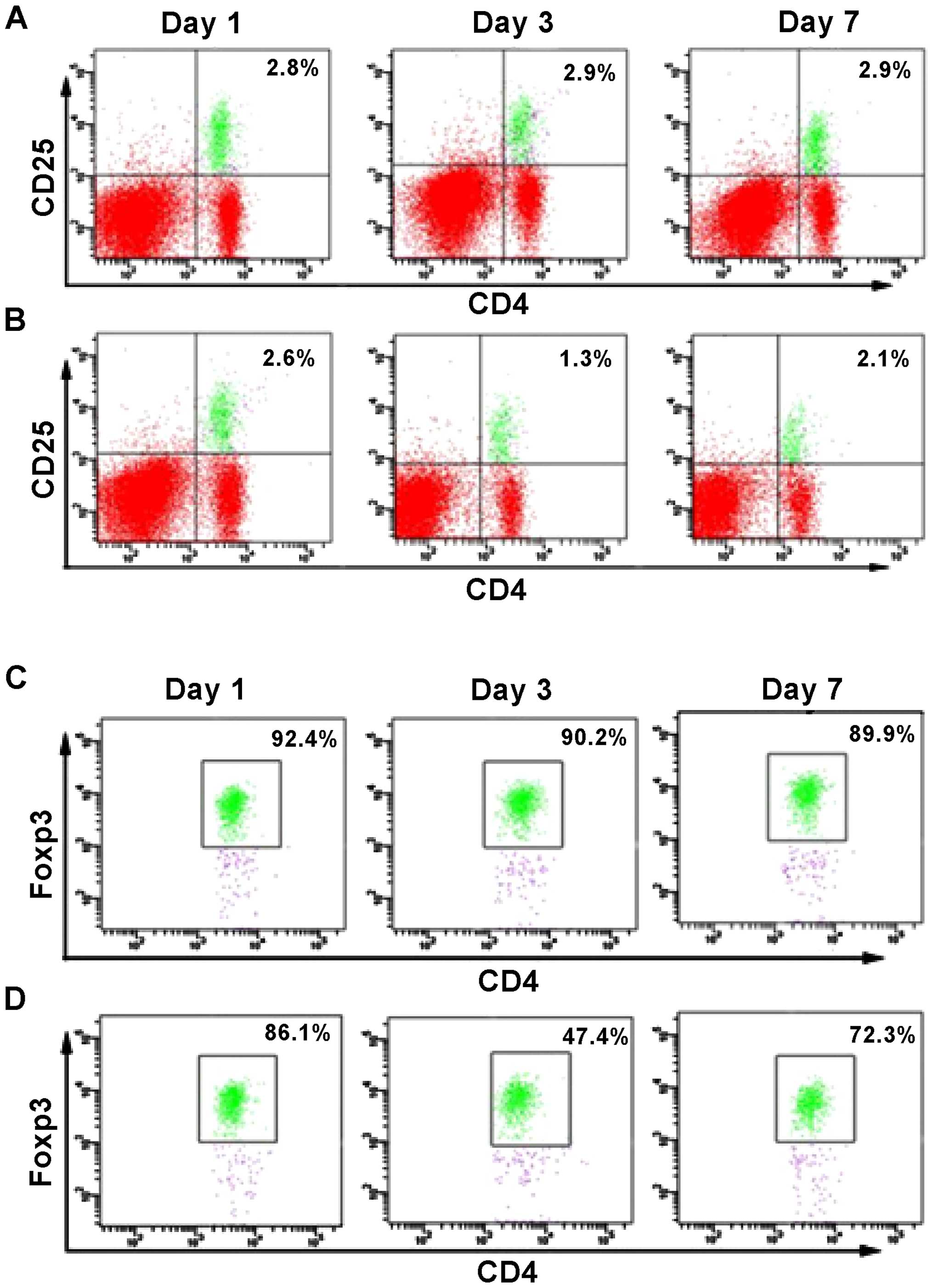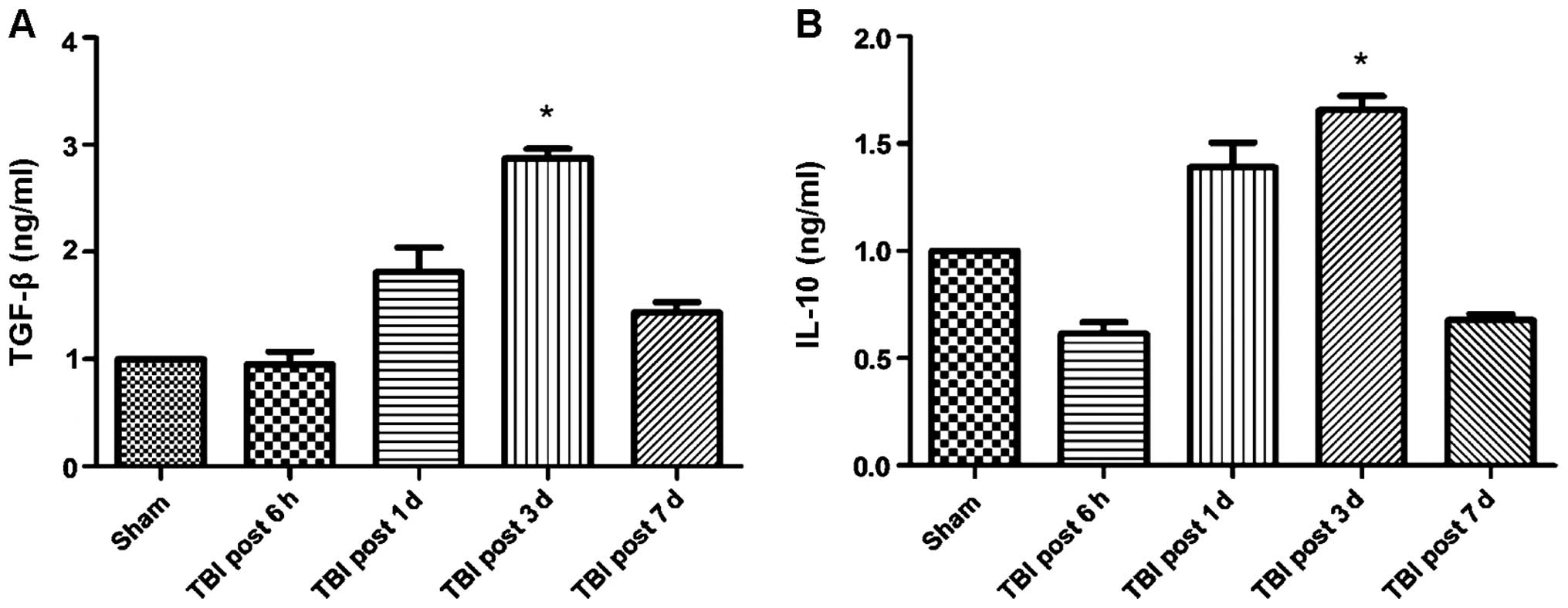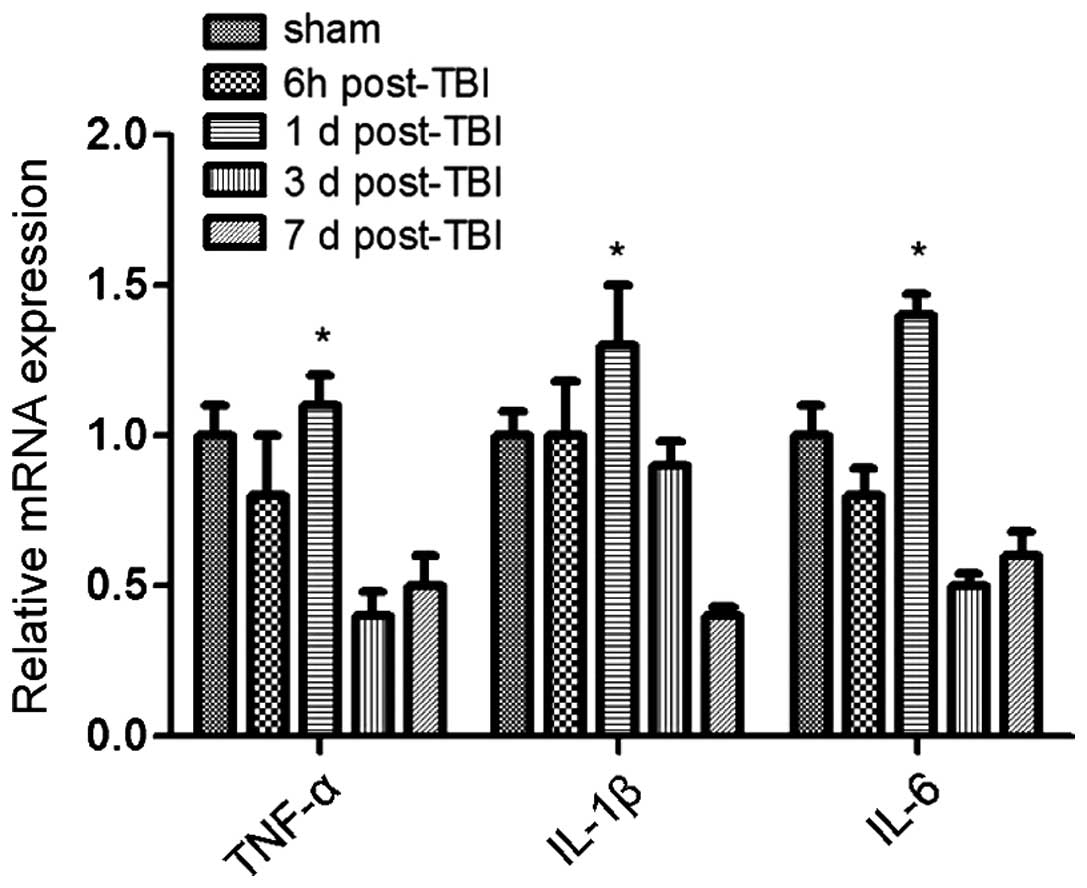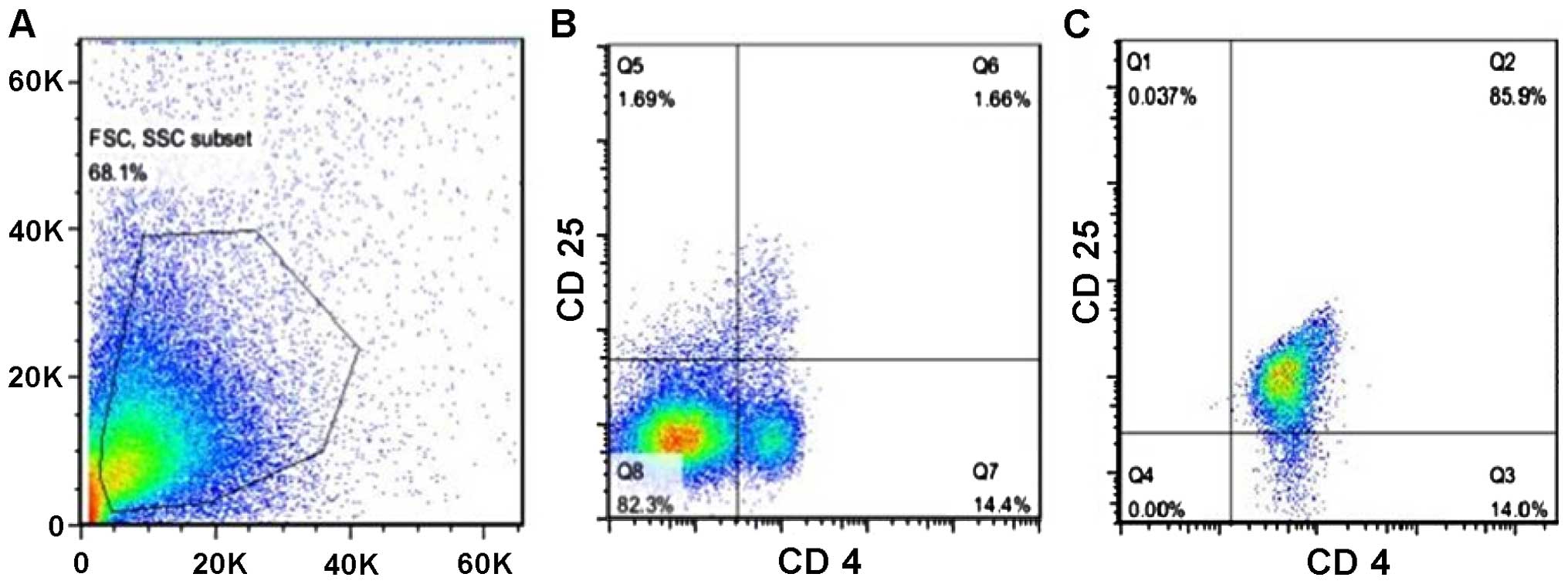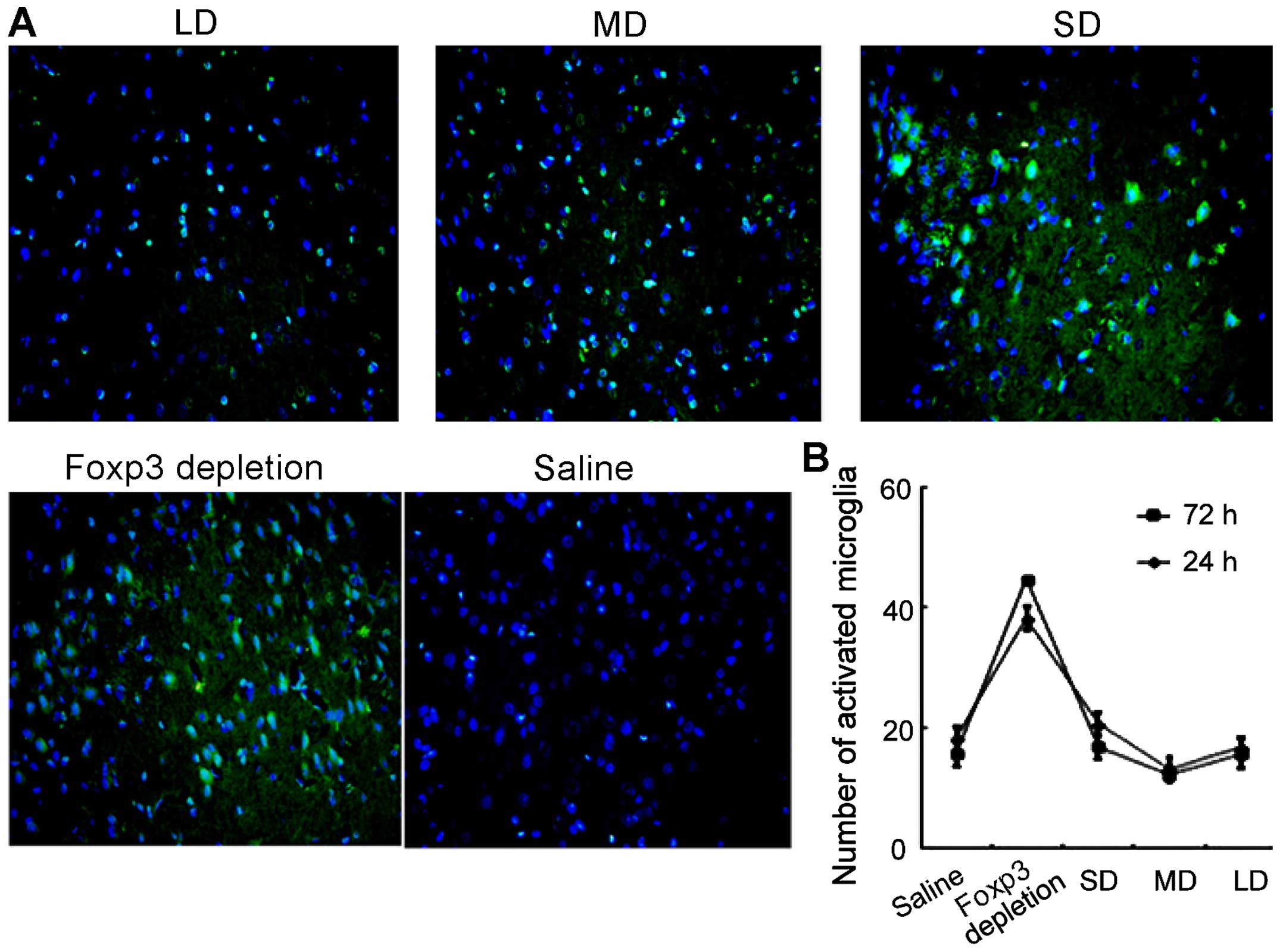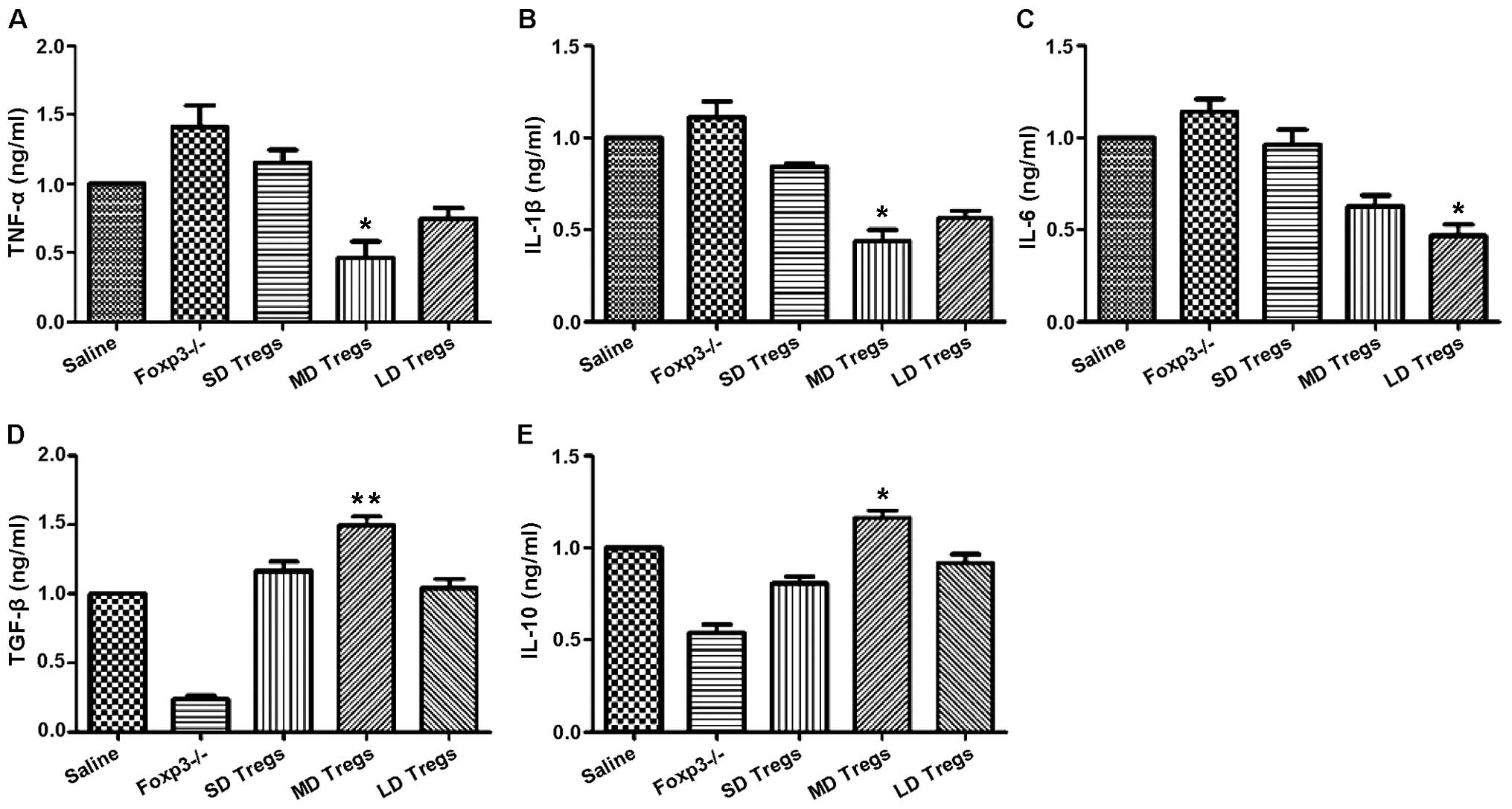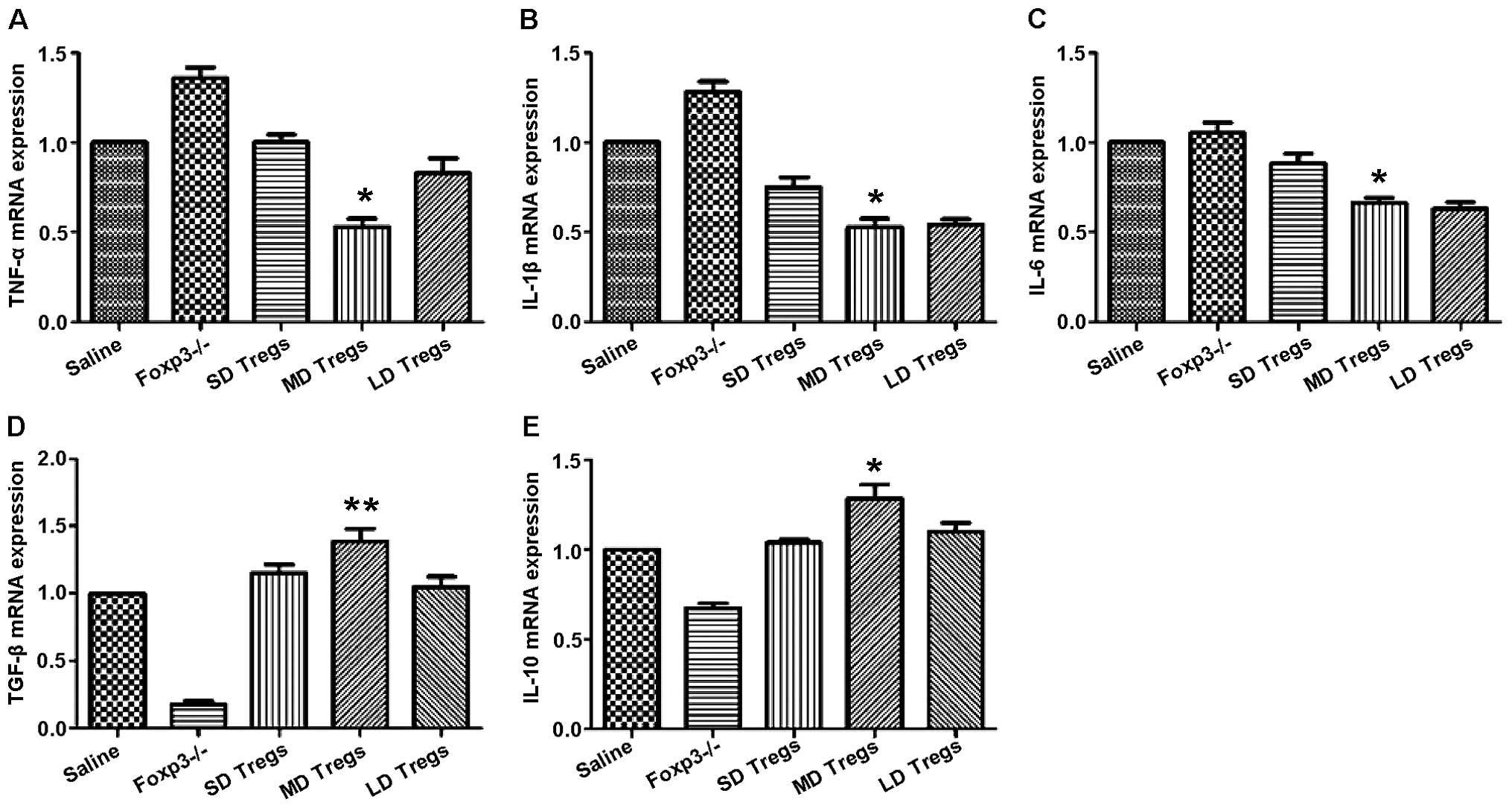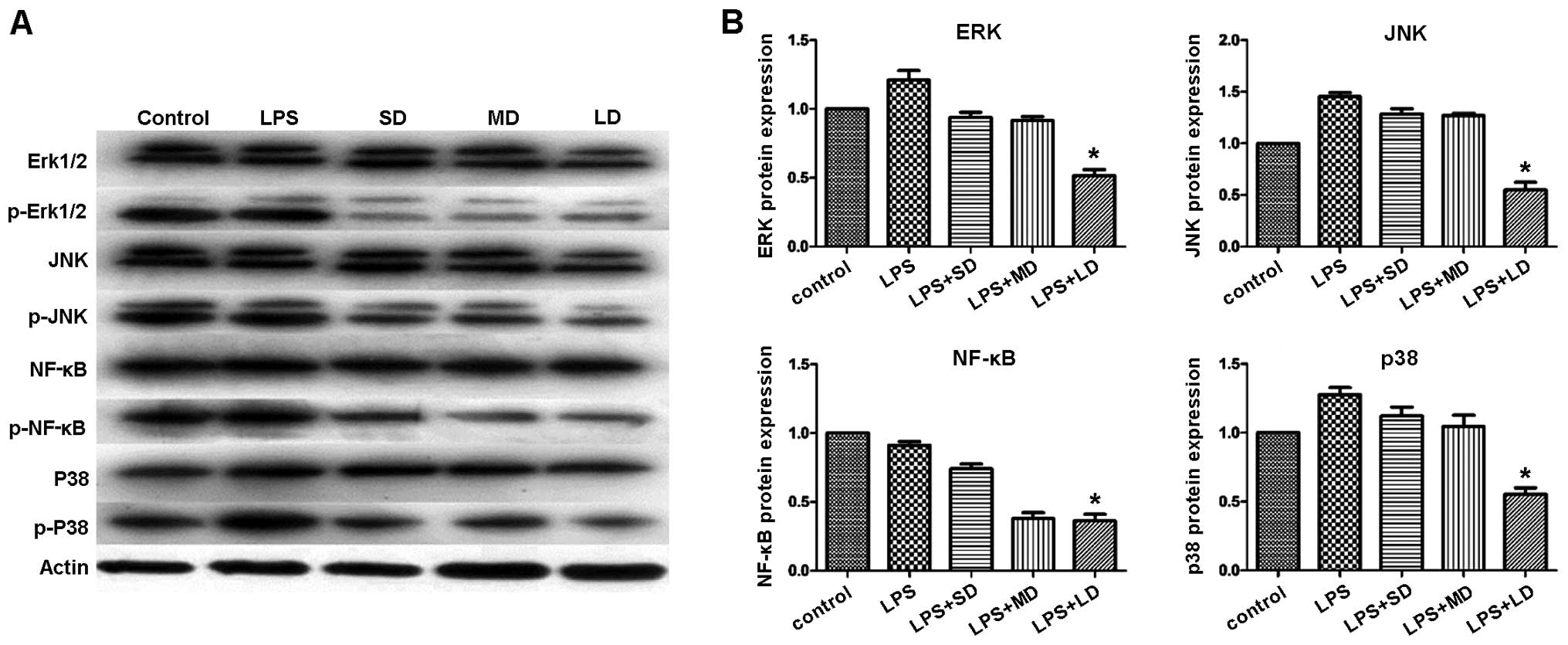Regulatory T cells exhibit neuroprotective effect in a mouse model of traumatic brain injury
Retraction in: /10.3892/mmr.2017.6299
- Authors:
- Published online on: November 18, 2016 https://doi.org/10.3892/mmr.2016.5954
- Pages: 5556-5566
-
Copyright: © Yu et al. This is an open access article distributed under the terms of Creative Commons Attribution License.
Abstract
Introduction
Traumatic brain injury (TBI) is normally caused by an external mechanical force that traumatically injures the brain. It can be classified based on severity, nature of the impact or other features (1–3). Currently, TBI is one of the major causes of death and disability worldwide, especially in children and young adults. The number of young cases that suffer from brain injuries has been drastically increasing over the years (1,2).
Although the number of drugs that are capable of ameliorating cerebral injuries remain scarce, a significant progress has been made in understanding the pathological mechanism of TBI and in developing a possible treatment. It is known that following the occurrence of TBI, other events such as inflammatory reactions, oxidative stress responses, and cytotoxicity injuries develop, and together they elicit a secondary craniocerebral injury, mainly driven by the inflammatory component (4,5). The inflammatory reaction in the brain usually involves the necrosis or death of numerous neurons as well as the activation of microglial cells (6–8). Peripheral blood lymphocytes, neutrophil granulocytes and thrombin invade the central nervous system (CNS), passing through the injured blood-brain barrier (9–12). Consequently, the expression of many cytokines is up- or downregulated at the same time that resident microglia cells are activated. Previous studies suggested that TBI, of either moderate or severe levels, induces chronic microglial activation that may negatively affect prognosis. It was also suggested that the activation of these cells may be the result of delayed cell death and tissue loss (5). Overall, all these changes in the immune system further exacerbate the apoptosis and necrosis of neurons, aggravating the injury and further impairing the neurological function (13–15).
On the other hand, recent studies have demonstrated that regulatory T cells (Tregs) are involved in immunomodulation, alleviating the inflammatory reaction and tissue damage (6–12). CD4 T cells that constitute Tregs are usually associated with CD25 and FoxP3 markers. Sakaguchi et al (13) confirmed that CD25 is a surface phenotypic marker for suppressive CD4 cells in mice. On the other hand, FoxP3 belongs to the forkhead/winged-helix family of transcription factors, acting as the ‘master regulator’ in the establishment of Tregs as a terminally differentiated and lineage committed subset of CD4 T cells (13).
Tregs can reduce cerebral infarction and improve behavioral function, and are positively associated with neuro-regeneration and alleviation of local inflammation. They have also shown to regulate immunity and inflammation in several diseases, including brain ischemia, viral myocarditis, inflammatory bowel disease, and myasthenia gravis (16,17). However, their underlying pathological and physiological mechanisms continue unknown. In certain studies in atherosclerosis, it was found that Tregs stimulate the secretion of anti-inflammatory cytokines of interleukin (IL)-10 and transforming growth factor (TGF)-β (18–22).
Since few studies have examined the function of Tregs in TBI patients, little is known about the physiological functions of Tregs in this condition. However, clinical trials have corroborated that the upregulation of Tregs in TBI patients significantly improves their clinical condition (12). Therefore, more studies are required to confirm their neuro-protective effects in TBI, since a better understanding can remarkably improve diagnosis, treatment and prognosis of the condition, as well as provide theoretical basis for novel treatment of TBI.
By analyzing the expression of Tregs and corresponding cytokines in the peripheral and CNSs, the present study aimed to elucidate the association between the changes of the immune system and in presence of TBI, by upregulating and downregulating the Tregs concentration in a mouse model of TBI.
Co-cultures of Tregs and microglia cells were performed to determine the immunological effect of Tregs. Our data showed that Tregs considerably suppressed microglia activation, while in the group of Treg depletion, microglia activation exhibited the highest level.
Moreover, JNK and p38 MAPK signaling pathways have been reported as critical factors during neuro-inflammation. In the current study, the expression patterns of JNK1/2/3, p38 MAPK, ERK1/2 and NF-κB proteins were identified among all the studied groups. However, our findings suggested that in the group with exogenous Treg injection, the expression levels of JNK1/2/3, p38 MAPK, ERK1/2 and NF-κB proteins were significantly reduced, compared to their levels in other groups. The data indicated that Tregs attenuate the inflammatory response by suppressing the JNK and NF-κB signaling pathways.
Materials and methods
Animals
C57BL/6 mice, 6–8 weeks of age, were used in the current study. Animals were randomly separated into two groups, sham and TBI group. In both groups, food and tap water were provided without restriction and the housing temperature was strictly controlled. All the animal protocols were approved by the Committee of Ethics and performed at Animal Experiments of the Experimental Animal Research Institute. Every effort was made to minimize animal suffering.
Mouse controlled cortical impact (CCI) model of moderate TBI
The CCI model was used to induce traumatic brain injuries in mice. TBI group consisted of 8 mice, which were anesthetized via IP injection of a Ketamine/xylazine mixture (87.7 mg/ml Ketamine and 12.3 mg/ml Xylazine) (1 ml/kg). The heads of mice were shaved between the ears and sterilized with 10% iodine, followed by 70% ethanol. Subsequently, a midline incision was performed to expose the skull, and the anatomical landmarks Lambda (caudal aspect) and Bregma (frontal aspect) were identified, by drawing a circle in the center with a 4 mm diameter and 0.5 mm away from the midline. The marked circle was cut along and the bone dust was gently blown away, in case the dura mater was damaged. Afterwards, the injury was achieved by introducing the impactor tip into the brain with a 1.0-mm depth of impact. The diameter of the impactor tip was 3 mm. Parameters to produce moderate TBI were set as follows: the velocity of the actuator was 3 m/sec, and impact duration was 100 msec. After injury, the area was carefully cleaned from any residual blood with a cotton-tipped applicator. Once bleeding stopped, the wound was sutured. The mice then returned a the clean cage and recovered from the surgery. The sham group consisted of 7 mice, which did not receive the injury.
The comparison of Treg levels between TBI group and Sham group were conducted at days 1, 3 and 7 post-injury. Brain tissues were harvested, fixed and embedded with paraffin for further examination of the number of Treg cells present at these time points. Formalin-fixed hematoxylin-eosin stained sections were also examined by a pathologist, who was blinded to the status of the mice, by light microscopy.
Splenocyte isolation
All the steps were performed under a sterile laminar flow hood to assure sterility of the procedure. Animals were euthanized by cervical dislocation. After sterilization of the abdomen area with 70% ethanol, a first transversal cut, without opening the peritoneal cavity, was performed. The peritoneal sac was identified and excised in order to collect the spleen. The spleen was cleared from residual debris and fat tissue, by washing it twice with 1X phosphate-buffered saline (PBS). Subsequently, the spleen was cut in two halves, by using microscope glass slides previously sterilized with 70% ethanol and fire. Spleen contents were removed by squeezing the two halves between the slides to extract the cellular matrix contained within the spleen capsule. The remaining fibrous tissue was discarded and cell aggregates obtained from this procedure were resuspended in complete RPMI-1640 medium.
Lysis of erythrocytes
Red blood cells were lysed by resuspending the obtained cell pellet in 5 ml of ACK buffer for 90 sec. Immediately afterwards, the cell suspension was washed with 45 ml of 1X PBS to remove any residual of the ACK buffer. Cells were centrifuged at 400 × g for 10 min and subsequently resuspended in 10 ml of 1X PBS. Successful lysis of red cells was confirmed by the presence of a white cellular pellet. Number of cells were determined.
Magnetic sorting of Tregs
CD4+CD25+ Tregs were isolated from 1×108 splenocytes, and according to the manufacturer's guideline (cat. no. 130-091-041; Miltenyi Biotec GmbH, Bergisch Gladbach, Germany). Specifically, splenocytes were labelled with 100 µl of biotinylated antibody cocktail specific for non-CD4+ T cells and diluted with 400 µl of RPMI-1640 10% FBS for 15 min, then 200 µl of the antibody specific for biotin and conjugated with microbeads was added and further diluted with 300 µl of RPMI-1640 10% FBS and the mix was incubated for 10 min. After labeling, cells were washed once with RPMI-1640 10% FBS and re-suspended in 6 ml of RPMI-1640 containing 10% FBS. Indirect separation of CD4+ cells was obtained by loading 2 ml of the labeled cells onto an LD separation column (Miltenyi Biotec GmbH). During this procedure, CD4-negative cells remained in the column, since the magnetic beads were attached to their surfaces, whereas, CD4-positive cells, flew through the column and were finally collected in a new tube. The final number of CD4+ cells was determined.
The cell population was further enriched in Tregs through a positive selection of CD25+ cell surface marker. Briefly, the obtained cells were labeled with an antibody against CD25-PE, and incubated for 15 min. The cells were incubated for another 15 min, but this time in the presence of an anti-PE antibody conjugated with microbeads (Miltenyi Biotec GmbH). The cells were washed once with 10 ml of RPMI 10% FBS and then re-suspended in 6 ml of complete medium. CD4+CD25− cells were separated from CD4+CD25+ cells by loading the labelled mix into the LS positive selection column (Miltenyi Biotec GmbH), 1 ml at a time. Finally, CD4+CD25+ cells were collected and quantified.
Flow cytometry analysis
The detection of CD4+CD25+ cells with CD4-FITC and anti-CD25-PE antibodies was performed as follows: 2.5×105 CD4+CD25+ cells were resuspended in 100 µl of PBS 0.2% BSA. 1 µl of each antibody: CD4-FITC and anti-CD25-PE was added to the sample (1:100 dilution). After 10 min incubation, the cells were washed and analyzed using flow cytometry to determine the obtained cell purity. Generally, an 80% purity of CD4+CD25+ cells can be achieved with this protocol, according to the manufacturer's instructions.
In vitro expansion of Tregs
In the present study, we used mouse Treg expansion kit (cat. no. 130-095-925; Miltenyi Biotec GmbH) to conduct in vitro expansion of Treg cells. All procedures were carried out according to the manufacturer's instructions. Treg cells were resuspended at a concentration of 2×106 cells/ml in complete culture medium containing 2,000 U/ml rIL-2. Tregs (50 µl) were incubated with 50 µl of CD3/CD28 MACSiBead Particles in a well of a 96-well flat bottom plate (day 0). At day 1, 100 µl media including 2,000 U/ml IL-2 was added, and at day 3, cells were split and then 100 µl medium including 2,000 U/ml rIL-2 was added. After 7 days of culture, CD3/CD28 MACSiBead Particles were removed together with the CD3/CD28 cells bound to them by magnetic cell separation. Treg population was collected for further analysis.
Immunohistochemistry. The paraffin-embedded tissue from each group was cut into 6 µm sections and repaired with high voltage. Sections were cooled at RT and then rinsed twice in deionized water and threse times in PBS (5 min/wash). The sections were incubated with FOXP3 primary antibody (1:400, ab20034; Abcam, Cambridge, UK) diluted in 2% BSA at 4°C overnight. Not bound FoxP3 antibodies were removed by rinsing the tissue twice with PBS (2 min/wash). Finally, the non-biotinylated goat anti-rabbit IgG secondary antibody was incubated with the primary antibody for 20 min at room temperature (RT), followed by three rinses with PBS (5 min/wash). The colored reaction product was developed using Simple Stain DAB solution.
Isolation and culture of microglia cells
Procedures were conducted under sterile conditions. The base of a 75 cm2 culture flask was coated with 5 ml poly-D-lysine (10 µg/ml) and allowed to set overnight at RT. Excess of poly-D-lysine was removed and the flask was washed once with PBS. The cleaned culture cabinet was exposed to additional 30 min of UV light to maximize the sterilization process. Brains from five fetal BALB/c mice (1–3 days old) were harvested and subjected to disruption by incubating them with 2 ml of trypsin/EDTA (0.05/0.02%) solution, in the incubator at 37°C for 10 min to allow for enzymatic disaggregation. Following neutralization of the trypsin with media, large pieces of tissues were further disaggregated by passing the cell suspension through a 70 µm nylon cell strainer. Finally, the suspended cells were added to a poly-D-lysine coated flask and were allowed to grow for 10–14 days, replacing the media every 3 days. Once the cells were 80–90% confluent, they were transferred to a poly-D-lysine pre-coated 24-well tissue culture plate (1×105 cells/well) and incubated at 37°C in a humidified 5% CO2 atmosphere. Within three days of culture, the obtained cells were assayed for their purity by flow cytometry using the anti-CD11b monoclonal antibody.
Western blotting analysis
Protein extracts from mouse brain tissues were obtained by grinding the tissue into powder in liquid nitrogen with RIPA buffer. The extracted proteins were quantified using BCA assay kit (Thermo Fisher Scientific, Waltham, MA, USA). Subsequently, 40 µg of protein extracts were separated by SDS-PAGE, then transferred onto a PVDF membrane (Millipore Corp., Billerica, MA, USA) for detection of specific proteins. The membranes were blocked for 30 min at RT with 5% non-fat dry milk and incubated for 2 h with primary antibodies. All the primary antibodies: ERK1/2 (cat. no. ab17942, diluted 1:1,000), JNK1+JNK2+JNK3 antibody (EPR18841-95) (cat. no. ab208035, diluted 1:1,000), JNK1+JNK2+JNK3 (phospho T183+T183+T221) (cat. no. ab124956, diluted 1:1,000), p38 MAPK (cat. no. ab197348, diluted 1:1,000), p38 (phospho Y182) antibody (cat. no. ab47363, diluted 1:1,000) were purchased from Abcam. Western blot analysis were conducted by incubating the membrane with the above-mentioned antibodies overnight in a humidified container at 4°C. Following binding of primary antibodies to the specific proteins in the extract, the membrane was washed with PBST three times and finally incubated with HRP-conjugated secondary antibody for 2 h. The specific proteins were detected and quantified using ECL (Millipore, Corp.) and Quantity One software (Bio-Rad, Berkeley, CA, USA).
RNA extraction and qPCR analysis
Total RNAs from the tissues of TBI and sham groups were isolated from harvested cells and mouse brain tissues with TRIzol (Invitrogen Life Technologies, Carlsbad, CA, USA), according to the manufacturer's instructions. RNAs were reverse transcribed using the PrimeScript™ RT-PCR kit (Takara Bio, Dalian, China). Real-time PCR reactions were performed using SYBR Premix DimerEraser system (Takara Bio). The PCR primers were designed as follows: IL-10 forward, 5′-ACAACATACTGCTAACCGACTCCT-3′ and reverse, 5′-TGCTCCACTGCCTTGCTCTTAT-3′; and TGF-β forward, 5′-TGTCGTGGCAGTCCTTCTCAA-3′ and reverse, 5′-GCAGGTCAATGTCGGTGTAGC-3′. The PCR primers for tumor necrosis factor (TNF)-α were: forward, 5′-AGCCAGGAGGGAGAACAGAAAC-3′ and reverse, 5′-GCCACAAGCAGGAATGAGAAGAG-3′; The PCR primers for IL-1β were: forward, 5′-ATCTCGCAGCAGCACATCAAC-3′ and reverse, 5′-TAGAGCGTCGTCGTGTAGTTG-3′; The PCR primers for IL-6 were: forward, 5′-CCACCAAGAACGATAGTCAATTCCA-3′ and reverse, 5′-GGTATCCTCTGTGAAGTCTCCTCTC-3′. PCR cycles were carried out by initial denaturation at 95°C for 5 min, then running 40 cycles of 95°C for 10 sec and 60°C for 1 min. Duplicate experiments were conducted to calculate the mean ΔΔCq, mean RQ (fold-change) and standard deviation.
ELISA
The level of each protein, TGF-β, IL-1β, IL-10, IL-6 and TNF-α, was determined with ELISA, using the following commercial kits: TGF-β Quantikine ELISA kit (cat. nο. MB100B; R&D Systems, Inc., Minneapolis, MN, USA), IL-1β Quantikine ELISA kit (cat. nο. MLB00C; R&D Systems, Inc.), IL-10 Quantikine ELISA kit (cat. nο. M1000B; R&D Systems, Inc.), IL-6 Quantikine ELISA kit (cat. nο. M6000B; R&D Systems, Inc.) and TNF-α Quantikine ELISA kit (cat. nο. MB100B; R&D Systems, Inc.) Briefly, 100 µl of each standard and sample were incubated with pre-coated antibody plates for 2.5 h at RT with gentle agitation. Following an extensive wash with the provided buffer, 100 µl of biotinylated antibody were added to the wells for 1 h at RT with gentle shaking. The amount of cytokine present in the sample or standard solution present in each well was then determined by incubating the previous mix with 100 µl of streptavidin solution for 45 min at RT and then with 100 µl of TMB One-Step substrate reagent. The colorimetric reaction was stopped after 30 min of incubation at RT by adding 50 µl of stop solution to each well. The absorbance at 450 nm was immediately measured using a microplate reader (Bio-Rad, Hercules, CA, USA).
Statistical analysis
Results were presented as means ± standard error of the mean, and all the analysis were performed using GraphPad Prism software (GraphPad Software, Inc., San Diego, CA, USA) and SPSS 17.0 (SPSS, Inc., Chicago, IL, USA). Categorical variables were compared using Pearson Chi-square test, continuous variables between groups were compared using Student's t-test or ANOVA. The numbers of circulating Tregs at different time points were compared using ANOVA. P<0.05 was considered to indicate a statistically significant difference.
Results
A previous report (12) evidenced a reduced number of circulating Treg cells when patients suffered from TBI, compared to healthy individuals. However, it is unknown at which time point the number of Tregs is significantly affected by the presence of TBI. Therefore, we conducted flow cytometry analysis to determine the percentage of CD4+CD25+FoxP3+ cells at different days after the brain injury (Fig. 1B and D), and compared these values with the number of cells present in the sham control group (Fig. 1A and C). No significant change in the percentage of CD4+FoxP3+ and CD4+CD25+ cells was observed in the sham group. However, at day 1 after TIB induction, the percentage of FoxP3+ cells was reduced to 1.3% compared to 2.6%, which corresponded to the sham group. Similarly, the percentage of CD4+CD25+ cells was reduced to 47.4%, compared to 86.1% (sham group). However, the percentage of the two cell populations increased at day 7 post-induction of TBI, as a difference with the observed values at day 1. Thus, the results suggested that between 1 and 7 days following TBI, the number of FoxP3+ cells was significantly reduced in the mouse brain, with a difference from the control group. Notably, this decrease was more pronounced at day 3 post-induction of TBI (Fig. 1). These results also correlated with changes in cytokine levels. Specifically, the expression of the anti-inflammatory cytokines TGF-β and IL-10 increased over time following TBI induction, whereas the expression of pro-inflammatory cytokines TNF-α, IL-1β and IL-6 was significantly reduced (Figs. 2 and 3). Of note, this effect was more pronounced at 3 days post-induction of TBI, compared to 7 days. In addition, IHC staining for FoxP3 revealed that the expression of FoxP3 in the two TBI groups, contralateral and ipsilateral (Fig. 4), were significantly increased compared with the sham group.
Pre-clinical and clinical studies have reported that TBI can induce chronic, as well as acute neuro-degeneration. Among classical chronic neurodegenerative disorders, microglial activation has been identified to contribute to delayed cell death and tissue loss. Therefore, we examined the microglia cell involvement in this condition. As shown in Fig. 5, our data suggested that the activation of microglia cells was significantly higher at 1 day post-TBI, compared to the levels observed in the sham group.
In the animal model of cerebral hemorrhage, investigators found that the proliferation of Tregs after active immunization can stimulate the secretion of large amount of anti-inflammatory cytokines, thereby suppressing inflammatory reactions and mitigating tissue damage. Subsequently, the compromised neuro-functions were safeguarded effectively. In order to determine whether Tregs render a neuro-protective effect in the presence of TBI, we isolated Tregs from mouse spleens and enriched them by magnetic sorting and finally, we injected them back into the brain of mice from the TBI group. After the isolation and enrichment, the percentage of Tregs reached 85.9% purity (Fig. 6).
To investigate the role that Tregs play in immune-modulation, we subdivided mice that received the brain injury into five groups: i) Saline group; ii) Tregs depletion group; iii) small-dose (SD) group, treatment with 1.25×105 Tregs; iv) moderate-dose (MD) group, treatment with 2.5×105 Tregs; and v) large-dose (LD) group, treatment with 5×105 Tregs. After TBI development and, following euthanasia, the percentage of Tregs was measured for each group with flow cytometry. According to Fig. 7, the result showed a significant increase of Tregs in all the mouse groups, which received Tregs: 3.9% (LD), 5.4% (MD), 4.1% (HD), compared with the saline (1.9%) and Treg depleted (0%) groups. However, the mouse group that received intermediate dose of Tregs showed a higher amount of Treg, rather than the group that received the higher dose.
Furthermore, microglia activation was also evaluated using immunofluorescence. As shown in Fig. 8, levels of microglia activation were correlated with the expression of Tregs. In FoxP3 depletion group, the microglia activation level was the highest. However, as the dose of exogenous injection of Tregs continued to increase, the activation of microglia cells was suppressed. In the MD group, the microglia activation level was the lowest.
The degree and progression of inflammatory reactions were evaluated by measuring the expression levels of pro- and anti-inflammatory cytokines, using ELISA and PCR. Our results indicated that the expressions of anti-inflammatory cytokines (TGF-β, IL-10) were significantly higher in MD group compared to those of other groups (Fig. 9); the levels of pro-inflammatory cytokines, including IL-6, IL-1β, TNF-α, were significantly enhanced in FoxP3 depletion group (Fig. 9).
Previous studies reported that TBI induces a neuroinflammatory response that involves the infiltration of white blood cells into the CNS and activation of resident microglia. To investigate the correlation between microglia activation and TBI, IHC analysis was conducted in the following group: Saline, Treg depleted and mice injected with different concentrations of Tregs, using FoxP3 antibody. The results showed that in the group that received Treg cells, the activation of microglia was enormously hampered, compared to the activation in the csaline group and the Treg depleted group (Fig. 10). Our data revealed that Tregs inhibited the inflammatory response by suppressing the microglia activation.
To elucidate the underlying mechanism of the Treg-mediated immune suppression, we conducted western blot analysis. Specifically, we investigated the JNK-NF-κB signaling pathway. Detections of Erk1/2, p38 MAPK, NF-κB and JNK1 at the protein level were performed. Our results indicated that the expression levels of p-Erk1/2, p-p38 MAPK, p-NF-κB and p-JNK were significantly reduced in the groups treated with Tregs, especially in the MD group (Fig. 11), while the expression of total Erk1/2, p38 MAPK, NF-κB and JNK1 remained constant. These results indicated that Tregs suppressed inflammatory reactions by inhibiting the JNK-NF-κB pathway.
Discussion
Regulatory pathways mediated by Tregs constitute an essential homeostatic mechanism of the immune system (7–12). Distinct Treg subsets were found to coexist in the intestinal mucosa and mesenteric lymph nodes, including the ‘natural’ and ‘adaptive’ CD4+ forkhead box p3 (FoxP3+) Tregs, as well as Th1 and Th3 cells. Tregs that develop in the thymus are commonly known as natural Tregs (nTregs). Previous studies have reported that Tregs play a role in immunomodulation, and in the regulation of numerous cytokine expressions and several signaling pathways (23,24).
Inflammation is characterized by an interplay modulation of pro- and anti-inflammatory cytokines. Cytokines are commonly classified as pro-inflammatory: IL-1, TNF, interferon (IFN)-γ, IL-12, IL-18, whereas, IL-4, IL-10, IL-13, IFN-α and TGF-β are considered anti-inflammatory cytokines (25–31). In the present study, the inflammatory response was evaluated by comparing the expression levels of anti-inflammatory cytokines (IL-10, TGF-β) and pro-inflammatory cytokines (TNF-α, IL-1β, IL-6) between TBI and Sham groups, using qPCR and ELISA analysis. Our data suggested that the expression of IL-10 and TGF-β was significantly lower in TBI group compared with those in the sham group, while the expression of TNF-α, IL-1β, IL-6 was significantly higher in the injured group compared with their expression in the sham group. However, after increasing the concentration of Tregs in the TBI group, the expression of IL-10 and TGF-β was enhanced, while the expression of TNF-α, IL-1β, and IL-6 was decreased, compared to the sham group (32–36). Therefore, we concluded that the development of TBI can elicit an inflammatory reaction, albeit its effect can be neutralized and may even be reversed by the presence of Tregs.
The CNS is considered an immune-privileged site because the entry of lymphocytes to this area is tightly controlled by the endothelial blood-brain barrier (BBB) and blood-spinal cord barrier (BSCB) (27–29). Under normal conditions, the number of leukocytes travelling into the CNS is small, however, in the presence of TBI and its associated secondary inflammatory reaction, a large number of circulating immunocompetent cells readily gain access into the CNS. This enhanced vascular permeability and increased leukocyte cell infiltration into the CNS during TBI is due to severe BBB and BSCB alterations.
Besides the leukocytes infiltration into the CNS, inducible Tregs (iTregs) are also developed from naïve CD4 T cells (nTregs) in the lymphoid tissues (37). This induction takes place in response to an adequate antigen stimulation and in the presence of anti-inflammatory cytokines, such as TGF-β and IL-10, while in the absence of pro-inflammatory cytokines such as IL-6, IL-12 and IFN-γ. By contrast, after TBI, Treg levels are significantly increased, possibly due to the trafficking of nTregs and iTregs into the CNS (22).
Microglia, a common immune cell that resides in the CNS, has been also involved in the TBI pathophysiology. Microglia are considered a source of highly cytotoxic substances. By delivering deriving oxygen-free radicals, subsequent reaction products, hydrogen peroxide and peroxynitrite, microglia are potentially able to injure cells, produce oxidative damage and induce neurodegeneration. Increased immunoreactivity in the brain was detected after TBI, followed by the accumulation and activation of microglia cells (25,30).
To investigate the interplay between Tregs and microglia cells, we conducted an experiment consisting of five groups: i) Saline (control), ii) TBI, iii) TBI+SD Treg, iv) TBI+MD Tregs, and v) TBI+LD Tregs. In the TBI group, the maximized effect of accumulation and activation of microglia cells was observed, while, in the TBI+SD Treg group, microglia activation induced by TBI was suppressed, compared to the control group. Similar trend was detected using the IHC method. Accordingly, qPCR and ELISA analysis confirmed that the expression of pro-inflammatory cytokines (TNF-α, IL-1β, and IL-6) in the TBI group were significantly higher than that in any other group, while the expression of TNF-α, IL-1β, and IL-6 was significantly decreased in the TBI+MD Tregs group. The results were consistent with the results of Sakaguchi (31). Our experiments showed that Tregs suppress the inflammatory response, thereby exhibiting neuroprotective effects and improving prognosis of TBI in the mouse model.
The current study focused on identifying the immunomodulatory role of Tregs in the mouse model of TBI, confirming the immune suppressive and neuroprotective functions of Tregs. The findings of the present study provide theoretically basis for the development of novel methods for TBI management and treatment.
Acknowledgements
The present study was supported by GuiZhou Province Scientific Award for Society Development SY (2012) 3118.
References
|
Brasure M, Lamberty GJ, Sayer NA, Nelson NW, Macdonald R, Ouellette J and Wilt TJ: Participation after multidisciplinary rehabilitation for moderate to severe traumatic brain injury in adults: a systematic review. Arch Phys Med Rehabil. 94:1398–1420. 2013. View Article : Google Scholar : PubMed/NCBI | |
|
Faden AI: Microglial activation and traumatic brain injury. Ann Neurol. 70:345–346. 2011. View Article : Google Scholar : PubMed/NCBI | |
|
Whalen MJ, Carlos TM, Wisniewski SR, Clark RS, Mellick JA, Marion DW and Kochanek PM: Effect of neutropenia and granulocyte colony stimulating factor-induced neutrophilia on blood-brain barrier permeability and brain edema after traumatic brain injury in rats. Crit Care Med. 28:3710–3717. 2000. View Article : Google Scholar : PubMed/NCBI | |
|
Ahn MJ, Sherwood ER, Prough DS, Lin CY and DeWitt DS: The effects of traumatic brain injury on cerebral blood flow and brain tissue nitric oxide levels and cytokine expression. J Neurotrauma. 21:1431–1442. 2004. View Article : Google Scholar : PubMed/NCBI | |
|
Readnower RD, Chavko M, Adeeb S, Conroy MD, Pauly JR, McCarron RM and Sullivan PG: Increase in blood-brain barrier permeability, oxidative stress, and activated microglia in a rat model of blast-induced traumatic brain injury. J Neurosci Res. 88:3530–3539. 2010. View Article : Google Scholar : PubMed/NCBI | |
|
Liesz A, Suri-Payer E, Veltkamp C, Doerr H, Sommer C, Rivest S, Giese T and Veltkamp R: Regulatory T cells are key cerebroprotective immunomodulators in acute experimental stroke. Nat Med. 15:192–199. 2009. View Article : Google Scholar : PubMed/NCBI | |
|
Ishibashi S, Maric D, Mou Y, Ohtani R, Ruetzler C and Hallenbeck JM: Mucosal tolerance to E-selectin promotes the survival of newly generated neuroblasts via regulatory T-cell induction after stroke in spontaneously hypertensive rats. J Cereb Blood Flow Metab. 29:606–620. 2009. View Article : Google Scholar : PubMed/NCBI | |
|
Shi Y, Fukuoka M, Li G, Liu Y, Chen M, Konviser M, Chen X, Opavsky MA and Liu PP: Regulatory T cells protect mice against coxsackievirus-induced myocarditis through the transforming growth factor β-coxsackie-adenovirus receptor pathway. Circulation. 121:2624–2634. 2010. View Article : Google Scholar : PubMed/NCBI | |
|
Strisciuglio C and van Deventer S: Regulatory T cells as potential targets for immunotherapy in inflammatory bowel disease. Immunotherapy. 2:749–752. 2010. View Article : Google Scholar : PubMed/NCBI | |
|
Liu R, Zhou Q, La Cava A, Campagnolo DI, Van Kaer L and Shi FD: Expansion of regulatory T cells via IL-2/anti-IL-2 mAb complexes suppresses experimental myasthenia. Eur J Immunol. 40:1577–1589. 2010. View Article : Google Scholar : PubMed/NCBI | |
|
Meng X, Zhang K, Li J, Dong M, Yang J, An G, Qin W, Gao F, Zhang C and Zhang Y: Statins induce the accumulation of regulatory T cells in atherosclerotic plaque. Mol Med. 18:598–605. 2012. View Article : Google Scholar : PubMed/NCBI | |
|
Li M, Lin YP, Chen JL, Li H, Jiang RC and Zhang JN: Role of regulatory T cell in clinical outcome of traumatic brain injury. Chin Med J (Engl). 128:1072–1078. 2015. View Article : Google Scholar : PubMed/NCBI | |
|
Sakaguchi S, Sakaguchi N, Asano M, Itoh M and Toda M: Immunologic self-tolerance maintained by activated T cells expressing IL-2 receptor alpha-chains (CD25). Breakdown of a single mechanism of self-tolerance causes various autoimmune diseases. J Immunol. 155:1151–1164. 1995.PubMed/NCBI | |
|
Sakaguchi S, Miyara M, Costantino CM and Hafler DA: FOXP3+ regulatory T cells in the human immune system. Nat Rev Immunol. 10:490–500. 2010. View Article : Google Scholar : PubMed/NCBI | |
|
Vignali DA, Collison LW and Workman CJ: How regulatory T cells work. Nat Rev Immunol. 8:523–532. 2008. View Article : Google Scholar : PubMed/NCBI | |
|
Yuan R, Maeda Y, Li W, Lu W, Cook S and Dowling P: Erythropoietin: A potent inducer of peripheral immuno/inflammatory modulation in autoimmune EAE. PLoS One. 3:e19242008. View Article : Google Scholar : PubMed/NCBI | |
|
Dénes A, Humphreys N, Lane TE, Grencis R and Rothwell N: Chronic systemic infection exacerbates ischemic brain damage via a CCL5 (regulated on activation, normal T-cell expressed and secreted)-mediated proinflammatory response in mice. J Neurosci. 30:10086–10095. 2010. View Article : Google Scholar : PubMed/NCBI | |
|
Bassil R, Zhu B, Lahoud Y, Riella LV, Yagita H, Elyaman W and Khoury SJ: Notch ligand delta-like 4 blockade alleviates experimental autoimmune encephalomyelitis by promoting regulatory T cell development. J Immunol. 187:2322–2328. 2011. View Article : Google Scholar : PubMed/NCBI | |
|
Louveau A, Smirnov I, Keyes TJ, Eccles JD, Rouhani SJ, Peske JD, Derecki NC, Castle D, Mandell JW, Lee KS, et al: Structural and functional features of central nervous system lymphatic vessels. Nature. 523:337–341. 2015. View Article : Google Scholar : PubMed/NCBI | |
|
Sakaguchi S, Ono M, Setoguchi R, Yagi H, Hori S, Fehervari Z, Shimizu J, Takahashi T and Nomura T: Foxp3+ CD25+ CD4+ natural regulatory T cells in dominant self-tolerance and autoimmune disease. Immunol Rev. 212:8–27. 2006. View Article : Google Scholar : PubMed/NCBI | |
|
Ghajar J: Traumatic brain injury. Lancet. 356:923–929. 2000. View Article : Google Scholar : PubMed/NCBI | |
|
Ziebell JM and Morganti-Kossmann MC: Involvement of pro- and anti-inflammatory cytokines and chemokines in the pathophysiology of traumatic brain injury. Neurotherapeutics. 7:22–30. 2010. View Article : Google Scholar : PubMed/NCBI | |
|
Scheffold A, Murphy KM and Hofer T: Competition for cytokines: T(reg) cells take all. Nat Immunol. 8:1285–1287. 2007. View Article : Google Scholar : PubMed/NCBI | |
|
Zhang Q, Cui F, Fang L, Hong J, Zheng B and Zhang JZ: TNF-alpha impairs differentiation and function of TGF-beta-induced Treg cells in autoimmune diseases through Akt and Smad3 signaling pathway. J Mol Cell Biol. 5:85–98. 2013. View Article : Google Scholar : PubMed/NCBI | |
|
Nagamoto-Combs K, McNeal DW, Morecraft RJ and Combs CK: Prolonged microgliosis in the rhesus monkey central nervous system after traumatic brain injury. J Neurotrauma. 24:1719–1742. 2007. View Article : Google Scholar : PubMed/NCBI | |
|
Abbott NJ: Inflammatory mediators and modulation of blood-brain barrier permeability. Cell Mol Neurobiol. 20:131–147. 2000. View Article : Google Scholar : PubMed/NCBI | |
|
Amiry-Moghaddam M and Ottersen OP: The molecular basis of water transport in the brain. Nat Rev Neurosci. 4:991–1001. 2003. View Article : Google Scholar : PubMed/NCBI | |
|
Balda MS, Whitney JA, Flores C, González S, Cereijido M and Matter K: Functional dissociation of paracellular permeability and transepithelial electrical resistance and disruption of the apical-basolateral intramembrane diffusion barrier by expression of a mutant tight junction membrane protein. J Cell Biol. 134:1031–1049. 1996. View Article : Google Scholar : PubMed/NCBI | |
|
Di Giovanni S, Movsesyan V, Ahmed F, Cernak I, Schinelli S, Stoica B and Faden AI: Cell cycle inhibition provides neuroprotection and reduces glial proliferation and scar formation after traumatic brain injury. Proc Natl Acad Sci USA. 102:8333–8338. 2005. View Article : Google Scholar : PubMed/NCBI | |
|
Ramlackhansingh AF, Brooks DJ, Greenwood RJ, Bose SK, Turkheimer FE, Kinnunen KM, Gentleman S, Heckemann RA, Gunanayagam K, Gelosa G, et al: Inflammation after trauma: Microglial activation and traumatic brain injury. Ann Neurol. 70:374–383. 2011. View Article : Google Scholar : PubMed/NCBI | |
|
Sakaguchi S: Naturally arising Foxp3-expressing CD25+CD4+ regulatory T cells in immunological tolerance to self and non-self. Nat Immunol. 6:345–352. 2005. View Article : Google Scholar : PubMed/NCBI | |
|
Schwartz RH: Natural regulatory T cells and self-tolerance. Nat Immunol. 6:327–330. 2005. View Article : Google Scholar : PubMed/NCBI | |
|
La Cava A, Van Kaer L and Fu-Dong-Shi: CD4+CD25+ Tregs and NKT cells: Regulators regulating regulators. Trends Immunol. 27:322–327. 2006. View Article : Google Scholar : PubMed/NCBI | |
|
Balandina A, Lécart S, Dartevelle P, Saoudi A and Berrih-Aknin S: Functional defect of regulatory CD4(+)CD25(+) T cells in the thymus of patients with autoimmune myasthenia gravis. Blood. 105:735–741. 2005. View Article : Google Scholar : PubMed/NCBI | |
|
Fattorossi A, Battaglia A, Buzzonetti A, Ciaraffa F, Scambia G and Evoli A: Circulating and thymic CD4 CD25 T regulatory cells in myasthenia gravis: Effect of immunosuppressive treatment. Immunology. 116:134–141. 2005. View Article : Google Scholar : PubMed/NCBI | |
|
Liu R, La Cava A, Bai XF, Jee Y, Price M, Campagnolo DI, Christadoss P, Vollmer TL, Van Kaer L and Shi FD: Cooperation of invariant NKT cells and CD4+CD25+ T regulatory cells in the prevention of autoimmune myasthenia. J Immunol. 175:7898–7904. 2005. View Article : Google Scholar : PubMed/NCBI | |
|
Ji J and Cloyd MW: HIV-1 binding to CD4 on CD4+CD25+ regulatory T cells enhances their suppressive function and induces them to home to, and accumulate in, peripheral and mucosal lymphoid tissues: An additional mechanism of immunosuppression. Int Immunol. 21:283–294. 2009. View Article : Google Scholar : PubMed/NCBI |



